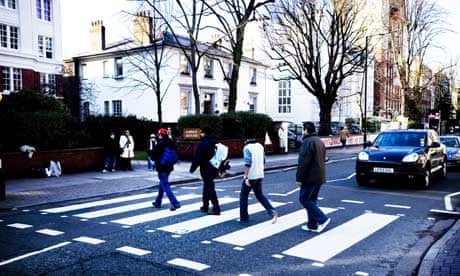Abbey Road, the London recording studios immortalised by the Beatles album, has become part of the nation's treasury of listed buildings, included at Grade II today by the government on the advice of English Heritage.
The news was announced by Simon Thurley, chief executive of English Heritage, who said: "Some of the most defining sounds of the 20th century were created within the walls of the Abbey Road studios. English Heritage has long recognised the cultural importance of Abbey Road – it contains, quite simply, the most famous recording studios in the world and acts as a modern day monument to the history of recorded sound and music."
Fears for the future of a pop music pilgrimage site for tourists from all over the world were eased at the weekend, with the announcement by EMI that it has no immediate plans to sell the building.
Its long-term viability, however, remains in question through seismic changes in the music industry, with micro-studios increasingly replacing large high-maintenance centralised facilities. EMI says it is holding preliminary discussions for the revitalisation of Abbey Road, which has been losing money for years.
The English Heritage announcement contained a discreet rap on the knuckles for the government, which delayed for seven years before deciding whether to list the building. Once the possible threat to the building's future attracted worldwide publicity, the culture minister, Margaret Hodge, decided in favour inside a week.
The announcement said: "In 2003 English Heritage advised ministers that the building possessed huge cultural importance and a remarkable and inspiring association with music making and should be listed."
In fact listing was first proposed in the 1990s, and at that point English Heritage opposed the move because the building was so much altered and had minimal architectural distinction. It was originally a Georgian suburban villa, which became the world's first purpose-built recording studios in the world.
By 2003 the English Heritage experts changed their mind, because the building is so famous and beloved. Tourists queueing to recreate the Beatles' Abbey Road cover by photographing one another on the pedestrian crossing regularly cause traffic jams. Sir Edward Elgar conducted the London Symphony Orchestra recording of Land of Hope and Glory there, and a near neighbour, Sir Malcolm Sargent, regularly recorded there. The studio launched Cliff Richard's 1958 mega-hit Move It, and in recent years the Manic Street Preachers, Travis and Blur have also worked there.
Protests and pleas came from all over the world when it was reported the building might be sold. The National Trust, which owns the childhood homes in Liverpool of Beatles John Lennon and Paul McCartney, said it would consider acquiring it, and the musicals composer and theatre owner Lord Lloyd-Webber also said he would be very interested in taking it on.
